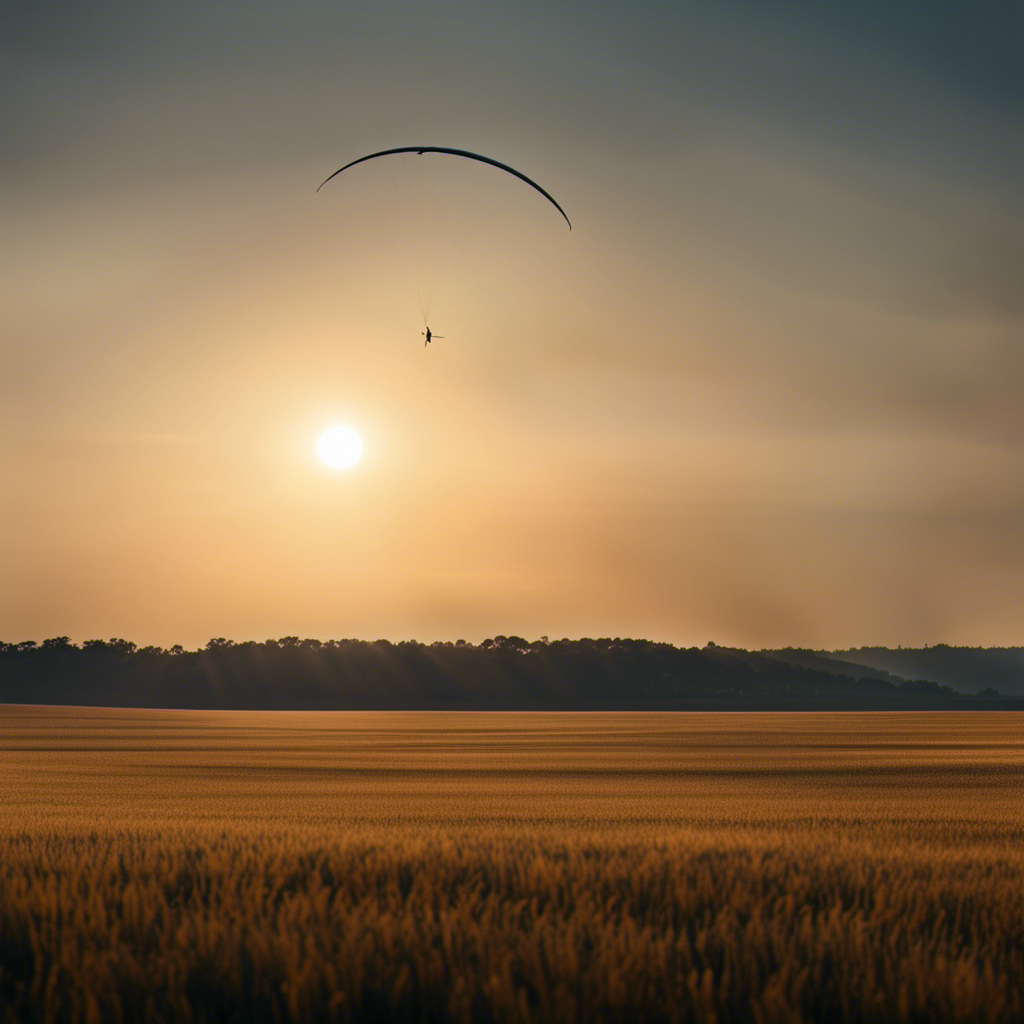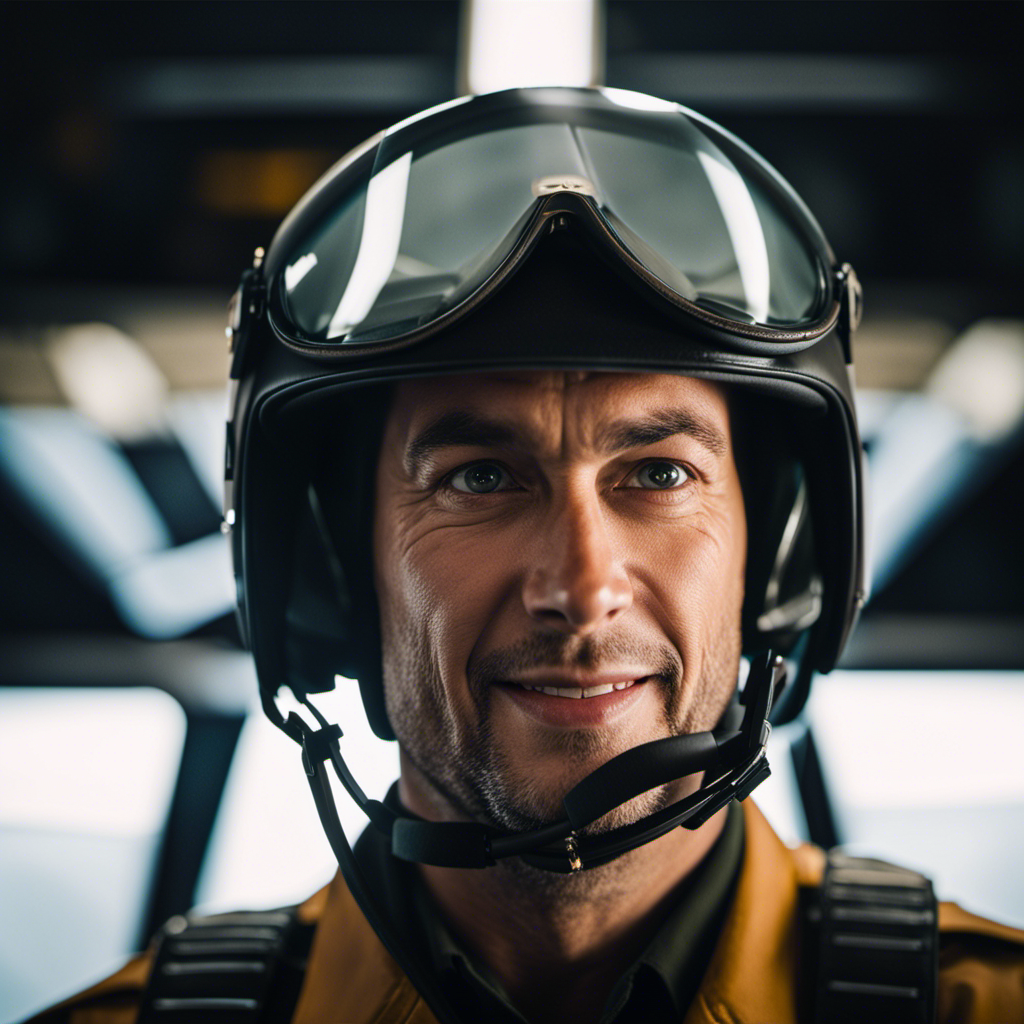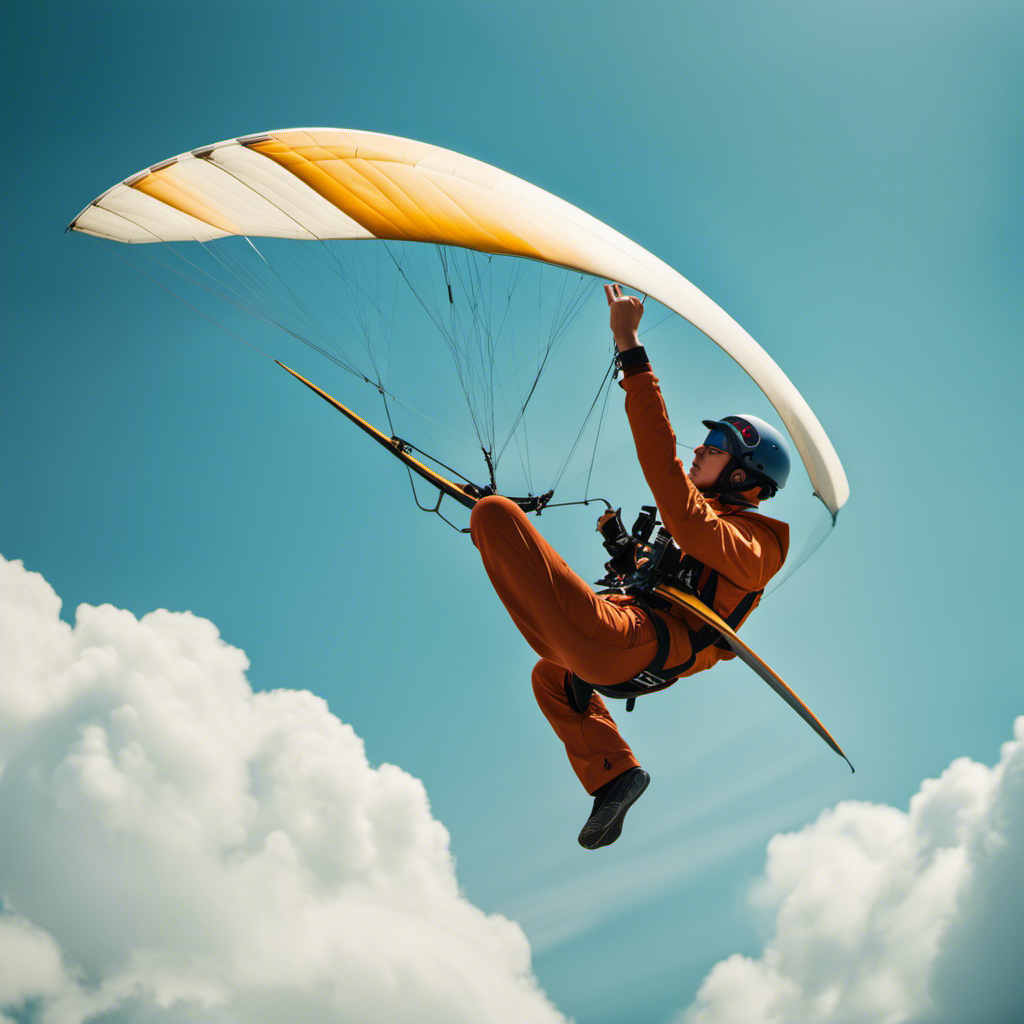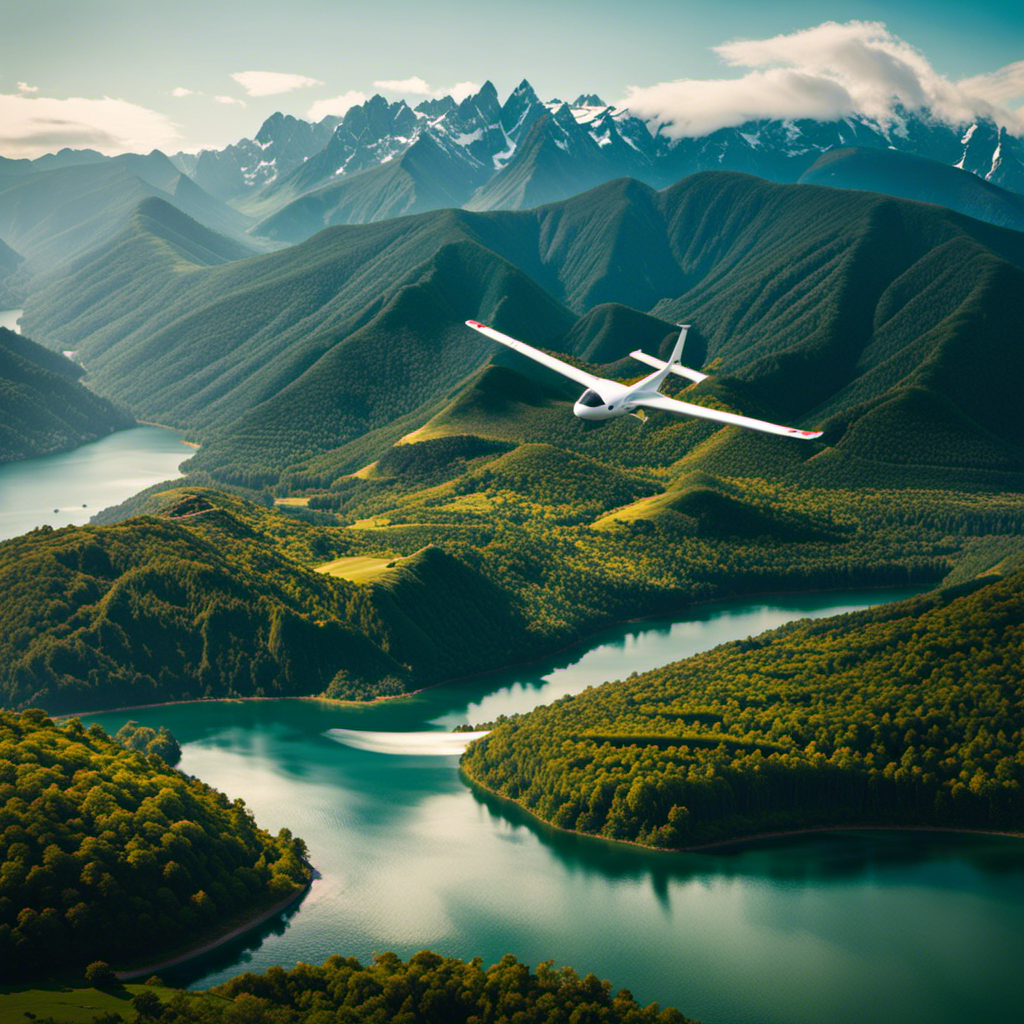Did you know that the typical age to fly a glider solo is 14? As an experienced glider pilot, I can attest to the exhilarating feeling of freedom and excitement when flying a glider on your own.
In this article, I will guide you through the ins and outs of glider flying, including the age requirements, training process, physical and mental fitness requirements, and safety measures.
Get ready to spread your wings and soar through the skies solo!
Key Takeaways
- The minimum age for soloing a glider varies but is typically between 14-16 years old.
- Different countries and glider associations have varying age restrictions and requirements.
- Parental consent is often necessary for minors to solo a glider.
- Ground school and flight training are essential for gaining the necessary knowledge and practical skills for solo flight.
The Basics of Glider Flying
Before you can solo a glider, you need to learn the basics of glider flying. As an experienced glider pilot, I know that understanding the age requirements and receiving proper flight training are crucial steps in becoming a proficient glider pilot.
When it comes to age requirements, it varies depending on the country and the glider association’s regulations. In most cases, individuals must be at least 14 or 16 years old to solo a glider. This ensures that they have the maturity and responsibility to handle the aircraft safely.
Additionally, flight training plays a vital role in building the necessary skills and knowledge to fly a glider independently. It includes learning about glider controls, aerodynamics, weather patterns, emergency procedures, and navigation techniques. By mastering these fundamentals, aspiring glider pilots can confidently navigate the skies and understand the age requirements that govern their solo flights.
Understanding the Age Requirements
As someone who has been involved in glider flying for many years, I can provide valuable insights on the topic of age requirements for soloing a glider.
It is important to understand that the minimum age for soloing a glider can vary between countries and organizations. Additionally, each country may have specific age restrictions for different types of gliders, such as single-seat or two-seat gliders.
Minimum Age for Soloing a Glider
The minimum age to solo a glider is usually 14-16 years old, depending on the country. Age restrictions exist to ensure that young pilots have the necessary maturity and skill to handle the responsibilities of flying solo. In most countries, parental consent is required for minors to undertake this thrilling experience.
As a glider pilot with years of experience, I understand the significance of these age restrictions. It is important for young pilots to demonstrate their ability to make decisions, handle emergencies, and navigate the skies safely.
Now, let’s explore the age restrictions for different countries, as they might vary in terms of the minimum age and specific requirements for soloing a glider.
Age Restrictions for Different Countries
Age restrictions for soloing a glider can vary across different countries, with some requiring pilots to be as young as 14. International regulations play a crucial role in determining the minimum age for solo flight. Here is a table showcasing age restrictions for soloing a glider in some countries:
| Country | Minimum Age |
|---|---|
| United States | 14 |
| United Kingdom | 16 |
| Australia | 15 |
| Germany | 14 |
| France | 15 |
As a glider pilot, it is important to be aware of these age restrictions when planning to fly abroad. Understanding and adhering to the regulations of the country you are flying in ensures safety and compliance with local laws. Now, let’s explore the training and certification process to become a solo glider pilot.
Training and Certification Process
When it comes to becoming a certified pilot, there are two key aspects to consider: ground school and flight training.
Ground school provides the necessary knowledge and understanding of aviation principles, regulations, and procedures.
Flight training, on the other hand, focuses on developing the practical skills required to safely operate an aircraft.
Additionally, aspiring pilots must meet the required flight hours and experience criteria set by the aviation authorities to obtain their certifications, ensuring they have the necessary practical experience to handle various situations in the air.
Ground School and Flight Training
Before soloing a glider, it’s important to complete ground school and flight training. Here are three key aspects to consider during this phase:
-
Ground School: This is where you learn the theoretical knowledge required for glider flying. Topics covered include aerodynamics, meteorology, navigation, and airspace rules. Ground school provides a solid foundation before you take to the skies.
-
Flight Training: This is the hands-on portion of your training. Under the guidance of an experienced flight instructor, you will learn the practical skills needed to safely operate a glider. This includes pre-flight checks, takeoffs, landings, maneuvering, and emergency procedures.
-
Progression Checks: Throughout your training, you will undergo periodic evaluations to assess your progress. These checks ensure that you are meeting the necessary requirements and are ready to advance to the next stage.
Completing ground school and flight training will prepare you for the required flight hours and experience needed to solo a glider.
Required Flight Hours and Experience
During your flight training, it’s essential to accumulate the necessary flight hours and gain adequate experience. As a pilot, you need to be proficient and confident in handling different flying situations.
The number of flight hours required before you can solo a glider can vary depending on your location and the flight school you attend. Generally, most flight schools require a minimum of 10-20 hours of flight time before allowing you to fly solo.
Age restrictions also play a role in determining when you can solo a glider. In most countries, the minimum age for soloing a glider is 14 to 16 years old. However, it’s important to note that these requirements can vary, so it’s crucial to check with your flight school for specific guidelines.
As you progress through your flight training and accumulate the necessary flight hours, you’ll also need to meet certain physical and mental fitness requirements, which we’ll discuss in the next section.
Physical and Mental Fitness Requirements
In order to solo a glider, you must meet certain physical and mental fitness requirements. The physical demands of flying a glider can be quite intense, requiring strength, coordination, and endurance. It is important to have good cardiovascular fitness, as well as muscular strength and flexibility. Mental fitness is just as crucial, as flying a glider requires sharp focus, quick decision-making, and the ability to remain calm under pressure. To give you a better understanding of the physical and mental fitness requirements for soloing a glider, I have provided a table below:
| Physical Fitness | Mental Fitness |
|---|---|
| Cardiovascular endurance | Sharp focus |
| Muscular strength and flexibility | Quick decision-making |
| Good hand-eye coordination | Ability to remain calm under pressure |
| Balance and agility | Problem-solving skills |
| Stamina and endurance | Situational awareness |
Meeting these physical and mental fitness requirements is essential for a safe and successful solo glider flight. Now, let’s move on to the next section where we will discuss the safety measures and precautions to take while flying a glider.
Safety Measures and Precautions
As an experienced pilot, I understand the importance of thorough pre-flight inspections and checklists. These measures ensure that all systems are functioning properly and that the aircraft is in a safe condition for flight.
Additionally, being well-versed in emergency procedures and receiving regular training is crucial for handling unexpected situations and ensuring the safety of myself and my passengers.
Pre-flight Inspections and Checklists
Before hopping into the glider, make sure you’ve completed all pre-flight inspections and checklists. Pre-flight preparations are crucial to ensure the safety and proper functioning of the glider. Equipment maintenance should be a top priority to prevent any potential issues during flight. Here is a helpful table outlining the key areas to inspect before taking off:
| Pre-flight Inspections | Checklists |
|---|---|
| Exterior of the glider | Control surfaces |
| Interior of the glider | Instruments and avionics |
| Canopy and cockpit | Emergency equipment |
| Wing and tail assembly | Fuel and oil levels |
Emergency Procedures and Training
Make sure to familiarize yourself with the emergency procedures and receive proper training to ensure you’re prepared to handle unexpected situations while flying.
Safety should always be the top priority when it comes to aviation.
In the event of an emergency, such as an engine failure or severe weather conditions, it’s crucial to know how to perform an emergency landing.
Familiarize yourself with the emergency equipment on board the glider, including the location and operation of the parachute, fire extinguisher, and first aid kit.
Additionally, practice emergency drills and scenarios during your training to build confidence and muscle memory.
By being well-prepared and knowledgeable in emergency procedures, you can mitigate risks and handle any unforeseen situation that may arise while flying.
This level of preparedness is essential before moving on to finding a glider club or school, where you can enhance your skills and gain further experience.
Finding a Glider Club or School
You can easily find a glider club or school by searching online and checking local aviation directories. When it comes to finding a glider instructor, it’s important to choose someone with experience and expertise in glider flying. Look for someone who can guide and teach you the necessary skills to become a proficient glider pilot.
Joining a glider club is another great way to immerse yourself in the gliding community and learn from experienced pilots. These clubs often offer training programs and access to gliders, making it easier for you to get started on your glider journey.
Once you have found a club or school and joined, you can begin preparing for your solo flight by familiarizing yourself with the glider, practicing maneuvers, and learning about weather conditions that are suitable for flying.
Preparing for Your Solo Flight
When it comes to preparing for your solo flight, there are key points that you need to focus on: practicing takeoffs, landings, and basic maneuvers.
These are the fundamental skills that you need to master before you can confidently take to the skies on your own.
Practicing Takeoffs, Landings, and Basic Maneuvers
To get better at takeoffs, landings, and basic maneuvers, it’s important to practice regularly. As an experienced glider pilot, I know the value of honing these essential skills.
Practicing takeoffs helps you master the technique of smoothly lifting off the ground and gaining altitude. By repeating landings, you become more proficient in judging distances and executing a safe touchdown.
Basic maneuvers, such as turns and climbs, require precision and finesse, which can only be achieved through consistent practice.
It’s worth noting that age restrictions for solo flying vary across countries. Some nations allow pilots as young as 14 to fly solo, while others require a minimum age of 16. Regardless of your age, regular practice is key to building confidence and skill in the glider cockpit.
Building Confidence and Skill
After spending countless hours practicing takeoffs, landings, and basic maneuvers, I have found that building confidence and improving skills are crucial in the world of gliding.
As a glider pilot, I have learned that confidence comes from repetition and experience. By continuously honing my skills, I have become more comfortable and self-assured in the cockpit. This confidence allows me to make better decisions, react quickly to changing conditions, and handle any challenges that may arise during flight.
Additionally, focusing on improving my skills has enabled me to become a more proficient pilot. Whether it’s perfecting my landings or refining my maneuvering techniques, every flight is an opportunity to grow and develop as a pilot.
With each flight, my confidence and skills continue to strengthen, paving the way for the next milestone in my gliding journey: taking my first solo flight.
Taking Your First Solo Flight
Once you’ve completed your training and gained the necessary skills, you can expect to experience the excitement of taking your first solo flight in a glider.
When it comes to age restrictions, the minimum age to solo a glider can vary depending on the country and the specific regulations in place. In the United States, for example, you must be at least 14 years old to solo a glider.
However, it’s important to note that age is just one aspect of the training process. The training process involves a combination of ground instruction, flight instruction, and practice flights with an instructor. It’s designed to ensure that you have the knowledge, skills, and confidence to safely operate a glider on your own.
Once you’ve successfully completed your first solo flight, you can continue your education and advancement in the world of gliding.
Continuing Education and Advancement
Continuing your education and advancement in gliding involves participating in advanced training courses and gaining experience through additional flight hours. To further develop your skills and knowledge, consider the following steps:
-
Enroll in advanced training courses: These courses are designed to enhance your understanding of advanced glider maneuvers, weather patterns, navigation techniques, and emergency procedures.
-
Seek mentorship: Connect with experienced glider pilots who can provide guidance and share their expertise. Learning from their experiences can greatly accelerate your progress.
-
Join gliding clubs or associations: These organizations offer opportunities for networking, access to resources, and exposure to new techniques and technologies.
-
Attend workshops and conferences: Stay updated on the latest advancements in gliding and engage with industry experts.
-
Pursue additional certifications: Acquiring specialized certifications, such as aerobatic or cross-country endorsements, can open doors for career advancement in gliding.
By continuously investing in your education and seeking opportunities for advancement, you can propel your gliding career to new heights.
As you hone your skills, it is essential to always prioritize safety and follow best practices to ensure a successful solo glider flying experience.
Safety Tips and Best Practices for Solo Glider Flying
To ensure a safe and successful flight, it’s important to familiarize yourself with safety tips and best practices for flying a glider alone.
When it comes to solo glider flying, there are certain age restrictions and solo flight requirements that must be followed. The age at which you can solo a glider varies depending on the country and the specific regulations in place. In the United States, for example, the minimum age to solo a glider is 14 years old.
However, it’s not just about meeting the age requirement. Before flying solo, you must also meet certain proficiency and skill criteria, which are determined by your flight instructor. These criteria typically include demonstrating a thorough understanding of glider operations, emergency procedures, and safe flying practices. Additionally, you must have logged a certain number of flight hours and have completed a specific number of solo flights under the supervision of your flight instructor.
Frequently Asked Questions
What is the minimum age requirement to take a solo glider flight?
The minimum age requirement to take a solo glider flight is typically 14 years old. This is part of the licensing process, which involves completing training, passing exams, and demonstrating proficiency in flying a glider.
Are there any maximum age limits for solo glider flights?
There are no maximum age limits for solo glider flights. However, it is important to meet the age requirement set by the glider flight school. Safety and experience are key factors when determining eligibility.
How long does the training and certification process typically take?
The training duration for glider certification typically takes several months. The certification process involves both theoretical and practical training, including learning about aerodynamics, meteorology, and flight maneuvers, as well as demonstrating proficiency in solo flights.
Are there any specific physical fitness requirements to fly a glider solo?
To fly a glider solo, you must meet certain physical readiness and health requirements. These include having good cardiovascular fitness, coordination, and the ability to handle the physical demands of flying.
What safety measures and precautions should be followed during a solo glider flight?
When flying a glider solo, it is crucial to prioritize safety. Wearing appropriate safety equipment and being familiar with emergency procedures is essential. Remember, "safety first" should always be your guiding principle.
Conclusion
In conclusion, solo glider flying is an exhilarating and rewarding experience that requires a combination of skill, knowledge, and responsibility.
By following the training and certification process, maintaining physical and mental fitness, and adhering to safety measures and precautions, one can safely take to the skies on their own.
Remember, continuing education and advancement are key to improving as a glider pilot. Always prioritize safety and follow the best practices to ensure a successful and enjoyable solo flight.
With a heart that soars as high as the skies, Aria, affectionately known as “Skylark,” is the driving force behind Soaring Skyways. Her journey into the gliding world began as a young dreamer gazing up at the soaring birds, yearning to experience the weightlessness and freedom they embodied. With years of experience both in the cockpit and behind the scenes, Aria’s commitment to the gliding community is unwavering.










